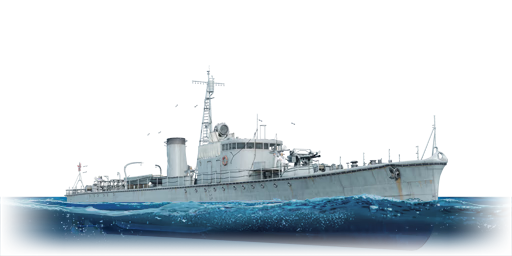

Coastal Fleet
Type K-7 No.4
III
Rank
AB
3.0
RB
3.0
Battle rating
Japan
Game nation
Heavy boat
Main role
36,000

Research
115,000

Purchase
General information
Camouflages
Specification
Armour
Hull
6 mm (steel)
Superstructure
4 mm (steel)
Number of sections
6
Displacement
314 t
Crew
59 persons
Max speed
Forward
37325641 km/h
Backward
14122216 km/h
Primary armament
2 × 40 mm/62 Vickers autocannon
Ammunition
4,400 rounds
Belt capacity
50 rounds
Reload
basic crew → aces
5.8 → 4.5 s
Fire rate
200 shots/min
Vertical guidance
-5 / 85°
Turret Rotation Speed
Horizontal
4538.34538.3 °/s
Vertical
3529.83529.8 °/s
| Belt | Belt filling | Armor penetration (mm) at a distance: | |||||
|---|---|---|---|---|---|---|---|
| 10 m | 100 m | 500 m | 1000 m | 1500 m | 2000 m | ||
| HEF/APHE/HEF/APHE | 36 | 35 | 30 | 25 | 22 | 20 | |
| HEF/HEF/HEF/APHE | 36 | 35 | 30 | 25 | 22 | 20 | |
| APHE/APHE/APHE/HEF | 36 | 35 | 30 | 25 | 22 | 20 | |
| HE-TF/HE-TF/HE-TF/HE-TF | 4 | 4 | 4 | 4 | 4 | 4 | |
Secondary armament
3 × Turret — 25 mm/60 Type 96 automatic cannon
Ammunition
4,500 rounds
Belt capacity
15 rounds
Reload
basic crew → aces
2.6 → 2 s
Fire rate
261 shots/min
Vertical guidance
-5 / 70°
Turret Rotation Speed
Horizontal
7563.87563.8 °/s
Vertical
6555.36555.3 °/s
| Belt | Belt filling | Armor penetration (mm) at a distance: | |||||
|---|---|---|---|---|---|---|---|
| 10 m | 100 m | 500 m | 1000 m | 1500 m | 2000 m | ||
| HEF-T/HEF/AP-T/HEI | 55 | 53 | 44 | 37 | 32 | 29 | |
| AP-T/AP-T/AP-T/HEF | 55 | 53 | 44 | 37 | 32 | 29 | |
| HEF-T/HEI/HEI/HEI | 5 | 5 | 4 | 4 | 4 | 4 | |
Additional armament
Setup 1
14 × Type 95 depth charge
Setup 2
16 × Type 95 depth charge
Setup 3
16 × Type 95 depth charge
14 × Type 95 depth charge
14 × Type 95 depth charge
Economy
Repair cost
Basic → Reference
AB
1,380 → 1,740 

RB
2,108 → 2,658 

Crew training
33,000 

Experts
115,000 

Aces
590 

Research Aces
360,000 

Reward multiplier
AB / RB
100 / 120 % 

148 % 

Total cost of modifications
35,300 

76,600 

Talisman cost
1,200 

Research order:
Seakeeping |
|---|
Unsinkability | |
|---|---|
Firepower | ||
|---|---|---|
Rating by players
You must play more than 3 battles for the last week and more than 10 battles in a vehicle to rate it.
Like:
5
Armor protection:
Not enough ratings
Survivability:
Not enough ratings
Mobility:
Not enough ratings
Armament:
Not enough ratings
Balance:
Not enough ratings
Tips & Tricks
This space is currently empty
Do you know any interesting vehicle features?
Loading...
No articles about this vehicle yet
Become the first author and get rewards!
Write a guide, tell about interesting historical facts, make a tutorial or simply an interesting post.
No more content